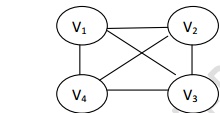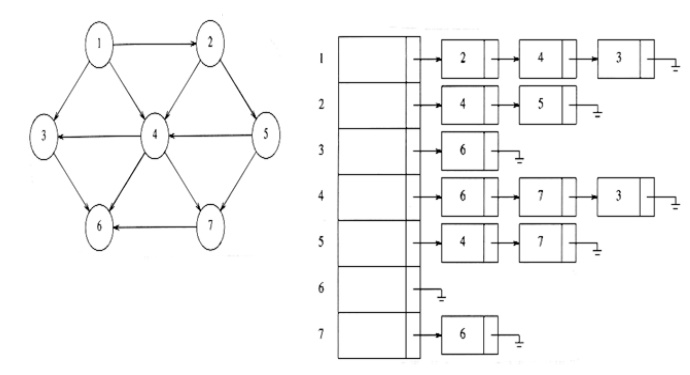Chapter: Programming and Data structures : Graphs
Representation of Graphs
REPRESENTATION
OF GRAPHS:
Graph
A graph G = (V, E) consists of a set of vertices,
V, and a set of edges, E. Vertices are
referred to as nodes. The arcs between the nodes are referred to as edges. Each
edge is a pair (v,w), where v,w Ōé¼ V. Edges are sometimes referred to
as arcs.

In the
above graph V1, V2, V3, V4 are the
vertices and (V1, V2), (V2, V3), (V3,
V4), (V4, V1), (V1, V3),
(V2, V4) are the edges.
Directed Graph (or) Digraph
Directed
graph is a graph, which consists of directed edges, where each edge in E is
unidirectional. In directed graph,
the edges are directed or one way. it is also called as digraphs. If (v,w) is a directed edge, then (v,w) ŌēĀ (w,v).

Undirected Graph
An
undirected graph is a graph, which consists of undirected edges. In undirected
graph, the edges are undirected or two way. If (v,w) is a undirected edge, then
(v,w) = (w,v).

Weighted Graph
A graph
is said to be weighted graph if every edge in the graph is assigned a weight or
value. It can be directed or undirected.

Subgraph
A
subgraph of a graph G = (V,E) is a graph G` = (V`, EŌƤ) such that V` V and EŌƤ E.
Symmetric digraph
A
symmetric digraph is a directed graph such that for every edge vw there is also
a
reverse
edge wv.
Symmetric undirected graph
Every undirected graph is a symmetric digraph where each undirected edge is considered as a pair of directed edges in opposite direction.
Complete Graph
A complete graph is a graph in which there
is an edge between every pair of vertices.
A
complete graph with n vertices will have n(n-1)/2.

A
complete graph is a strongly connected graph.
Strongly connected Graph
If there
is a path from every vertex to every other vertex in a directed graph then it
is said to be strongly connected graph. Otherwise, it is said to be weakly
connected graph.
Path
A path in a graph is defined as a sequence
of verices w1, w2, w3, . . . , wn
such that (w1, w2, w3, . . .) Ōé¼ E.
Where E is the number of edges in a graph. Path from A to D is {A, B, C, D} or
{A, C, D}
Path from
A to C is {A, B, C} or {A, C}
Length
The
length of a path in a graph is the number of edges on the path, which is equal
to NŌĆō1. Where N is the number of vertices.
Length of
the path from A to B is {A, B} = 1
Length of
the path from A to C is {A, C} = 1 & {A, B, C} = 2.
If there
is a path from a vertex to itself with no edges then the path length is 0.
Length of the path from A->A & B -> B is 0.
Loop
A loop in
a graph is defined as the path from a vertex to itself. If the graph contains
an edge (v,v) from a vertex to
itself, then the path v, v is sometimes referred to as a loop.
Simple Path
A simple path is a path such that all
vertices are distinct (different), except that the first and last vertexes are
same.
Simple
path for the above graph {A, B, C, D, A}. First and Last vertex are the same
ie. A
Cycle
A cycle in a graph is a path in which the
first and the last vertex are the same.
Cyclic Graph
A graph
which has cycles is referred to as cyclic graph. A graph is said to be cyclic,
if the edges in the graph should form a cycle.
Acyclic Graph
A graph
is said to be acyclic, if the edges in the graph does not form a cycle.
Directed Acyclic Graph (DAG)
A
directed graph is acyclic if it has no cycles, and such types of graph is
called as Directed Acyclic Graph.
Degree
The number of edges incident on a vertex determines its degree. The degree of the vertex V is written as degree (V).
Indegree : The indegree of the vertex V, is
the number of edges entering into the vertex V.
Outdegree: The outdegree of the vertex V, is
the number of edges exiting from the vertex V.

Representation of Graph
A Graph
can be represented in two ways.
i.
Adjacency Matrix
ii. Adjacency
List
Adjacency Matrix Representation
i.
Adjacency matrix for directed graph
ii.
Adjacency matrix for undirected graph
iii.
Adjacency matrix for weighted graph
Adjacency matrix for directed graph
One
simple way to represent a graph is Adjacency matrix. The adjacency matrix A for
a graph G = (V, E) with n vertices is an n x n matrix, such that
Aij
= 1, if there is an edge Vi to Vj Aij = 0, if
there is no edge

Adjacency matrix for undirected graph

Adjacency matrix for weighted graph

Here Aij
= Cij if there exists an edge from Vi to Vj.
(Cij is the weight or cost). Aij = 0, if there is no
edge.
If there
is no arc from i to j, C[i,j] = Ōł×, where i ŌēĀ j.
Advantage
├ś Simple to implement.
Disadvantage
├ś Takes O(n2)
space to represents the graph.
├ś Takes O(n2)
time to solve most of the problem.
Adjacency List Representation
In this
representation, we store the graph as a linked structure. We store all vertices
in a list and then for each vertex, we have a linked list of its adjacency
vertices.
Adjacency List for directed unweighted graph

Disadvantage of Adjacency list representation
It takes
O(n) time to determine whether there is an arc from vertex i to vertex j, since
there can be O(n) vertices on the adjacency list for vertex i.
Related Topics